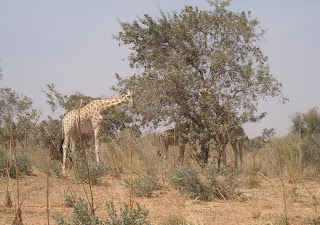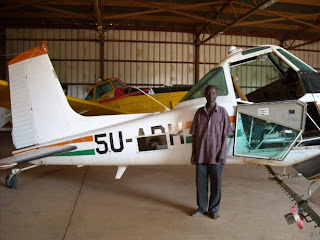January 26, 2009
January 21, 2009
January 20, 2009
A few more photos, without much logical organisation
The Niger River flows through Niamey.


In the countryside, on the way to the giraffes, we saw these granaries that are raised above ground and protected from animals with wooden fences.


These dromedaries had giraffe envy, eating out of trees and all that.

In a village, the bare baobab tree waits for the rainy season to bloom. In the meantime, he's happy to be decorated with some ears of maize.

Obviously people in villages don't have running water, and so they go the well to fetch water. I will post movies of this when I have a better connection.

Kids don't have to worry about getting toys from China, instead, they make their own with recycled garbage.

The area is populated by two ethnic groups, the Haoussa (sedentary farmers) and the Peul (animal husbands - what else do you call people who practice animal husbandry???). These are Peul cattle.



In the countryside, on the way to the giraffes, we saw these granaries that are raised above ground and protected from animals with wooden fences.


These dromedaries had giraffe envy, eating out of trees and all that.

In a village, the bare baobab tree waits for the rainy season to bloom. In the meantime, he's happy to be decorated with some ears of maize.

Obviously people in villages don't have running water, and so they go the well to fetch water. I will post movies of this when I have a better connection.

Kids don't have to worry about getting toys from China, instead, they make their own with recycled garbage.

The area is populated by two ethnic groups, the Haoussa (sedentary farmers) and the Peul (animal husbands - what else do you call people who practice animal husbandry???). These are Peul cattle.

January 19, 2009
Informal economy
The formal economy is very small, and so many people basically survive from whatever work they can find. This is even more true outside of Niamey. In these photos, you see harvested wood from the savana (dry wood only, I am told) being sold road-side to trucks wanting to take it to Niamey.
Since the population of Niamey has limited access to electricity or natural gas for cooking, many people cook on woodstoves. This leads to massive deforestation, of course, as woodland are not sustainably managed (or managed at all). In a final irony, some of this wood gets transported on the back of oil trankers, which shows that oil companies are into renewable energy - or that they don't pay their drivers enough.


Since the population of Niamey has limited access to electricity or natural gas for cooking, many people cook on woodstoves. This leads to massive deforestation, of course, as woodland are not sustainably managed (or managed at all). In a final irony, some of this wood gets transported on the back of oil trankers, which shows that oil companies are into renewable energy - or that they don't pay their drivers enough.


Kouré Giraffes
On Saturday morning, we headed out to Kouré to see the wild giraffes that live there. The Kouré giraffes are the last wild giraffes in West Africa, and they have bounced back in 10 years from 67 individuals to 205. This is a real success story in terms of concerted conservation, and the giraffe live in a populated, cultivated, and grazing area designated as a biosphere reserve for the benefit of the local population. The local population receives some of the proceeds of the visitors’ ticket prices, and compensation when the giraffes eat their crops (apparently they dig beans a lot).
The giraffes were very easily approachable. This being the dry season, they get around in small groups of fewer than 10 individuals. We saw a group of four comprising one young and 3 adult females, including a pregnant one. We were able to get out of the car and approach them on foot (as close as 30 feet, but I didn’t try to go closer), as they placidly ate leaves off the trees.
These giraffes, as you might notice, are lighter colored than East-African giraffes. This is one of their characteristics, and can be explained by the dry environment that they live in. Without further ado, here are the pictures.

This is the requisite “I was there” Japanese-tourist shot.

3 giraffes pigging out. The stalks you see in front are millet, which is left to stand after the stems are harvested to serve as food for the animals (cows, sheep, and goats).


At one point, the giraffes decided to check me out as well before going back to eating.

I'm with you, that leaf did look tasty.





They young one is slightly darker than the older ones.


The giraffes were very easily approachable. This being the dry season, they get around in small groups of fewer than 10 individuals. We saw a group of four comprising one young and 3 adult females, including a pregnant one. We were able to get out of the car and approach them on foot (as close as 30 feet, but I didn’t try to go closer), as they placidly ate leaves off the trees.
These giraffes, as you might notice, are lighter colored than East-African giraffes. This is one of their characteristics, and can be explained by the dry environment that they live in. Without further ado, here are the pictures.

This is the requisite “I was there” Japanese-tourist shot.

3 giraffes pigging out. The stalks you see in front are millet, which is left to stand after the stems are harvested to serve as food for the animals (cows, sheep, and goats).


At one point, the giraffes decided to check me out as well before going back to eating.

I'm with you, that leaf did look tasty.





They young one is slightly darker than the older ones.


January 17, 2009
Niamey Critters
There are lots of animals in Niamey. This picture shows a dromedary carrying a load at a busy intersection.

Donkeys are everywhere. These are lugging an enormous hay bail.

This donkey seems to have an easier job.

A red-eyed dove having a drink.

Some flowers.

Sorry, no pictures of goats yet, but they are coming, I promise.

Donkeys are everywhere. These are lugging an enormous hay bail.

This donkey seems to have an easier job.

A red-eyed dove having a drink.

Some flowers.

Sorry, no pictures of goats yet, but they are coming, I promise.
January 16, 2009
More from Niamey
My colleagues and I spent the day opening manholes and looking for leaks and lost pipes. I know you're all jealous that you too could spend your days doing this in the hot Sahel sun, but it's fun to me, and it's not hurting anyone. I took the time to take some pictures, and had a fun adventure.
Notice the word "Coiffeur" or hairdresser on the straw door to the shack.

As in so many places in Africa, people use mud bricks to build many structures.

Sometimes, however, they use wicker. These people are squatters and have no services whatsoever.

Zoom in to see the great use of metalic bottle tops as washers to ensure that the nails do not rip the through cardboard that makes up the walls.

Djibo, pictured below, is a mechanic with the air pesticide patrol - the so-called "Protection des végétaux" - and he and I had lunch together today.

I had been to his hangar a few times already to open and close the taps, as my colleagues and I open and shut valves on the network to see if we could pinpoint a leak and understand how the system was organised (we didn't). After a few stops, he was about to sit down for lunch and asked me to join him for some beef stew and French bread. He insisted, and I couldn't refuse without offending him. The stew was spicy and very good, and very much like the stews I used to eat in Uganda. It was warm and so I decided that it would be safe. I stuck to the sauce so as not to deprive this generous man of his lunch.
We had a great conversation about how he came to be a mechanic on this small Cesnas that fly crop duster missions to kill the various species of crikets, buggers, and - he leaned over to tell me softly - sometimes birds that destroy the crops that are so badly needed in the country. Such kind and warm welcome just doesn't happen in Europe or in the US anymore (or rarely); I just hope that my stomach won't make me regret it.
I have been struck so far by how well people speak French. I daresay their French is much easier to understand than some Anglophone Africans' English, particularly Liberians.
Notice the word "Coiffeur" or hairdresser on the straw door to the shack.

As in so many places in Africa, people use mud bricks to build many structures.

Sometimes, however, they use wicker. These people are squatters and have no services whatsoever.

Zoom in to see the great use of metalic bottle tops as washers to ensure that the nails do not rip the through cardboard that makes up the walls.

Djibo, pictured below, is a mechanic with the air pesticide patrol - the so-called "Protection des végétaux" - and he and I had lunch together today.

I had been to his hangar a few times already to open and close the taps, as my colleagues and I open and shut valves on the network to see if we could pinpoint a leak and understand how the system was organised (we didn't). After a few stops, he was about to sit down for lunch and asked me to join him for some beef stew and French bread. He insisted, and I couldn't refuse without offending him. The stew was spicy and very good, and very much like the stews I used to eat in Uganda. It was warm and so I decided that it would be safe. I stuck to the sauce so as not to deprive this generous man of his lunch.
We had a great conversation about how he came to be a mechanic on this small Cesnas that fly crop duster missions to kill the various species of crikets, buggers, and - he leaned over to tell me softly - sometimes birds that destroy the crops that are so badly needed in the country. Such kind and warm welcome just doesn't happen in Europe or in the US anymore (or rarely); I just hope that my stomach won't make me regret it.
I have been struck so far by how well people speak French. I daresay their French is much easier to understand than some Anglophone Africans' English, particularly Liberians.
Subscribe to:
Comments (Atom)



















